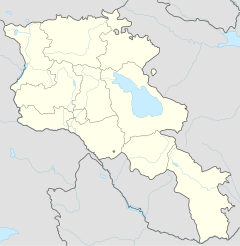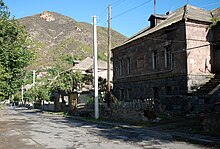Tumanjan (Lori)
|
Tumanjan Թումանյան |
||
| State : |
|
|
| Province : | Lori | |
| Coordinates : | 40 ° 59 ′ N , 44 ° 39 ′ E | |
| Time zone : | UTC + 4 | |
| Community type: | city | |
| Mayor : | Levon Sawarjan ( HHK ) | |
| Website : | ||
|
|
||
Tumanjan ( Armenian Թումանյան ), other transcripts Tumanian, Tumanyan , is an urban settlement in northern Armenia .
geography
city
It is located in the province of Lori , about 35 kilometers north of the provincial capital Vanadzor in the valley of the Debed at an altitude of 810 meters. The town center is a little higher on the slope. Above the train station and some houses are the ruins of the medieval Kobayr monastery , which can only be reached on a steep footpath.
Until 1951 the place was called Dzagidzor ( Dzaghidzor ). The name was changed in honor of the poet Hovhannes Tumanjan (1869–1923).
In 2002, 116 single-family houses and 28 apartment blocks were counted. Of the latter, a good half were over 20 years old and 39 percent were in poor condition.
A study classifies 58% of the population as poor and another 40% as very poor. Up to a third of the residents left the place looking for work in the 1990s. A study from 2002 ranked Tumanjan together with Stepanawan and Schamlugh among the ten poorest communities in the country.
region
The area around the Debed valley between Dsegh in the south and Snogh just before the Georgian border is called the Tumanjan region. In addition to the Tumanyan founded as industrial sites urban settlements include Alaverdi , Achtala and Schamlugh to this region. According to 2002 statistics, the region also includes 27 rural parishes and 34 smaller rural settlements. These have 7903 hectares of arable land. The population of the Tumanjan region was given for January 2003 with 48,800.
history
A first settlement in 1926 had 42 inhabitants. In 1943 the construction of a brick factory began to process the clay that was abundantly available in the area . During the Second World War , German prisoners of war were involved in the construction of the factory and the first residential buildings. The industrial site "Dzagidzor" had emerged by 1949, and was renamed "Tumanjan" in mid-1951.
In the Armenian Soviet Republic , Tumanjan was known for the production of refractory bricks as well as high-quality oxide ceramics and silicon carbide ceramics. In addition, a clothing factory offered jobs for women in the 1980s. 1200 workers were employed in the brickworks and around 200 women in the textile factory. The 1988 Spitak earthquake also caused great damage in Tumanjan.
When Armenia gained independence in 1991, the country's industry collapsed and the two factories in Tumanjan were also closed. In 1995 Tumanjan was declared an urban settlement as part of a regional reform.
Population development

Remarks:
- 2001: The figure includes 45 residents of the hamlet of Kobayr.
- 2009:
traffic
The M6 expressway runs past Tumanjan to the Georgian border. A junction in an easterly direction leads to the village after a few 100 meters.
Tumanjan also owns a train station on the Tbilisi – Yerevan railway line, which opened in 1899 .
economy
The collapse of the industry in Tumanjan could not be absorbed by other economic activities. The brick factory, privatized from 1995–1996, produces masonry bricks and roofing panels for house construction on the scale of a medium-sized enterprise: 10 to 15 workers are employed here. There is no money available for larger investments that could lead to an improvement in the quality of the products.
The place has no arable land. The residents keep animals (cows, pigs, chickens) and grow fruit and vegetables in their gardens for self-sufficiency. Meat, milk, dairy products, bread and honey come from local production. In addition, there is illegal logging of the surrounding forests.
According to official information from the authorities, the number of unemployed in Tumanjan in 2002 was 12%, above the national average of 10% (comparative figures for Stepanawan: 40% and for Spitak : 13.2%). The survey of the mayors revealed completely different figures. The mayors of Stepanawan and Tumanjan estimated the unemployment rate in their communities to be around 90% and were thus well above the figures of other community leaders. This makes Tumanjan the last of all municipalities in the province economically.
culture and education
There is a secondary school, a kindergarten, a sports school and a health station.
See also
Web links
- Rick Ney: Lori marz . Tour Armenia, 2007, p. 23
Individual evidence
- ↑ http://www.tumanyancity.am/Pages/DocFlow/Default.aspx?a=v&g=d719df0e-d2f9-4962-b4ed-2410e46c8173 (accessed January 4, 2020)
- ↑ a b Lise Grande (UN Resident Coordinator): Interim Poverty Reduction Strategy Paper. Armenia Social Trends 2004, pp. 36, 40, Annex 4
- ^ RA Lori Marz. armstat.am, p. 218
- ^ RA 2001 Population and Housing Census Results . armstat.am, p. 74
- ^ RA Lori marz. armstat.am, 2009, p. 235.
- ↑ Larisa Paremuzyan: The Mayor of Tumanyan Dreams of Turning His City Into a Veritable Hong Kong. hetq.am, January 21, 2008


